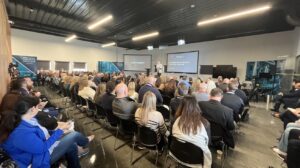By Stuart Gillen and Marla Rosner
Maintenance and operations in the wind industry can be dangerous. Even setting aside dramatic possibilities, such as blade failure or accumulated ice being thrown from a turbine, just doing routine maintenance gets tricky at heights of 100 to 200 feet.
When you think of new technologies to alleviate these concerns, natural language processing (NLP) is likely not the first thing to come to mind. NLP allows machines to use and understand language in much the same way as humans, utilizing written or spoken documents to process information and subsequently make decisions. It may not sound relevant for wind operations, but in fact, NLP’s applications for wind energy are numerous.
So what does NLP do? Traditionally, machines could only use structured data that had been carefully curated into formats algorithms can easily understand and search, such as spreadsheets and cleanly organized sensor data. According to Oracle, structured data only accounts for about 20% of generated data. The rest is locked away in emails, journals, notes, audio, video, images, analog data, and more. These sorts of records are taken by businesses but rarely used, since they have previously been accessible only to humans—but NLP can change that. An application powered by NLP is capable of using and understanding unstructured data, unlocking a vast wealth of valuable information.
This unstructured data can include information critical to safe operations, such as injury reports. For example, with one of the country’s largest wind operators, a keyword search of one their safety logs for “lower body injuries” resulted in 534 entries. A semantic search, which included ontologically related terms such as “leg,” “foot,” or “toe,” returned 1,027 results, many of which had nothing to do with actual injuries. A cognitive search using NLP, however, gave a far more accurate listing of 347 incidents, removing incorrect references to body parts, such as “foot” used as a unit of measurement, and focusing on references to body parts in the context of injuries.
Another successful example of NLP enhancing the cognitive search process was the query “Find incidents involving employees driving into animals.” The application was able to correctly return incidents with no mention of “driving” or “animals,” such as the following: “Coming to work in the dark and icy conditions, a deer ran in front of my vehicle. Was difficult to stop without sliding off the road.” Being able to so quickly and easily search through incident records means you can now use them to gain insights into working conditions and make your operations safer and more efficient.
Natural language processing also provides a natural interface for human and machine communication, wherein the machine can understand and respond to interactions in natural language, and also continually improves by learning from human questions and feedback. When a technician is high in the air on a turbine, they need to be able to identify and resolve problems immediately. With NLP, technicians can engage in a full dialog with machine applications to troubleshoot unexpected problems swiftly and accurately. This not only makes maintenance work safer and easier, but can greatly reduce asset downtime due to unexpected issues as well. A problem that can be quickly identified and resolved is a problem that won’t be interfering with smooth operations in the future.
Solutions don’t always come from expected sources. Efficient production and safe conditions are some of the biggest problems the wind industry currently faces—but better communication with your machines just might be the answer.
Check out our utility white paper, for more information!
















